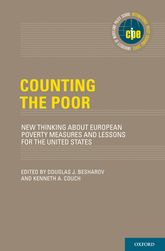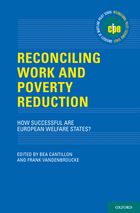
단행본International policy exchange series
Counting the poor: new thinking about European poverty measures and lessons for the United States
- 청구기호
- 339.46094 COU2012
- 발행사항
- Oxford ; New York : Oxford Univ. Press, 2012
- 형태사항
- 440 p
- ISBN
- 9780199860586
소장정보
| 위치 | 등록번호 | 청구기호 / 출력 | 상태 | 반납예정일 |
|---|---|---|---|---|
이용 가능 (1) | ||||
| 한국노동연구원 | 00006921 | 대출가능 | - | |
이용 가능 (1)
- 등록번호
- 00006921
- 상태/반납예정일
- 대출가능
- -
- 위치/청구기호(출력)
- 한국노동연구원
책 소개
The poverty rate is one of the most visible ways in which nations measure the economic well-being of their low-income citizens. To gauge whether a person is poor, European states often focus on a person''s relative position in the income distribution to measure poverty while the United States looks at a fixed-income threshold that represents a lower relative standing in the overall distribution to gauge. In Europe, low income is perceived as only one aspect of being socially excluded, so that examining other relative dimensions of family and individual welfare is important. This broad emphasis on relative measures of well-being that extend into non-pecuniary aspects of people''s lives does not always imply that more people would ultimately be counted as poor. This is particularly true if one must be considered poor in multiple dimensions to be considered poor, in sharp contrast to the American emphasis on income as the sole dimension. The book provides detailed discussions of specific issues from a European perspective followed by commentary from American observers. The volume considers current standards of poverty measurement in the European Union and the Organization for Economic Co-operation and Development, challenges in extending those measures to account for the value of the provision of in-kind and cash benefits from the government, the interaction of poverty measures with social assistance, non-income but monetary measures of poverty, and multi-dimensional measures of poverty.
목차
1.Introduction
Part One.European measures of income, poverty, and inequality
2.The OECD Approach to MEasuring Income Distribution and Poverty
3.Income Indicators for the EU''s Social Inclusiton Strategy
4.Deconstructing European Poverty Measures
Part Two.Broadening Measures of Income and Other Financial Resources
5.Accounting for the Distributional Effects of Noncash Public Benefits
6.Accounting for Imputed and Capital Income Flows
7.Accounting for Employee Benefits
8.Impressionistic Realism: a European Focus on US poverty Measurement
Part Three. Income Levels for social Assistance and Their Behavioral Effects.
9.Minimum-Imcome Benefits in OECD Countries
10.Social Assistance Schemes in Developing Countries
11.Europe''s Other Poverty Measures: absolute thresholds underlying social assistance
Part Four.Nonincome Monetary Measures
12.Asset-Based Measurement of Poverty
13.Consumption-Based Measures in Developing Nations: Lessons from Brazil
14.Alternatives to Income-Based Measures of Poverty
Part Five.Multidimensional Measures
15.Developing and Learning from EU Measure of Social Inclusion
16.Using Nonmonetary Deprivation Indicators to Analyze European Poverty and Social Exclusion
17.Poverty Redefined as Low Consumption and Low Wealth, Not just Low Income: Psychological consequences in Australia and Germany
18.Anomalies in European Measures of Poverty and social Exclusion
Part Six.Conclusion
19.New Comparative Measures of Income, Material Deprivation, and Well-Being


